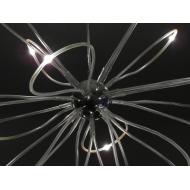An LED is a semiconductive device that emits light in the visible spectrum when current is applied to its tips. The polarity of the LED tips must be respected. These terminals are called the Anode (A) and the Cathode (K). By applying a positive voltage between the diode’s Anode and Cathode (Vanode>Vcathode) it becomes positively polarised and will emit light.
Cross section of LED lighting diode LED diode symbol
LED diode symbol
The basic parameters to be defined are the direct current (Vd) and the maximum direct current (Id max).
How is an LED powered? The LED Driver
A driver is a device that regulates the power of an LED or an LED strip. What distinguishes the LED driver from a conventional power source is that it meets the LED’s changing needs by means of a constant supply of power.
There are two different ways to feed an LED by means of a driver:
1) CONSTANT VOLTAGE:
a. This keeps a constant voltage at the driver output regardless of whether under load or not.
a. This is a very inefficient solution, given that a ballast has to be connected at the output to limit the current circulating through the LED, thus producing losses in the ballast.
2) CONSTANT CURRENT:
a. This keeps the current constant at the output regardless of the number of LEDs connected there.
b. The output voltage is determined by the number of LEDs connected in series.
c. This is a very efficient solution given there is no need for ballast resistors at the driver output. IDEAL FOR LIGHTING.
LED Lighting advantages
The following are just some of the advantages of LED lighting:
• Long service life that substantially reduces maintenance and replacement costs. 50,000 hours
• Greater response speed. Instant lighting.
• Clearer and brighter light. The LED chromatic scale is purer, thus the light is more natural for the human eye.
• Produces little heat: A conventional bulb wastes 95% of its electricity generating heat and uses only 5% for lighting purposes. LED lights operate at a cool temperature and thus do not waste energy producing heat, which means they do not damage nearby materials and so avoid fire risks.
• High efficiency and low consumption (lm/W). More light generated per watt used.
Why power LEDs with low currents?
The range of currents with which we can power an LED diode is extremely varied and depends on the type of LED in question. There are many different types of LED on the market today that accommodate the numerous applications used by designers.
Most LED driver manufacturers design them for variable output currents, but the most common values are as follows: 350mA, 500mA, 700mA, 1050mA, 1400mA, 2100mA…etc.
However, the ELT criterion when it comes to designing eLED Line strips is very clear, always favouring the service life of the LEDs.
Working with branches of LEDs in parallel means that the direct current for each one is low. The exact current that will pass through teach LED will be: ILED = Iinput / number of branches.
The number of LEDs connected in series determines the module voltage, thus by arranging a low number of LEDs in series you get low voltages. Therefore, the LED module voltage will be Vstrip = No. of LEDs in series × Vd (direct voltage).
Some of the advantages of powering LEDs with a low current are as follows:
• Service life is prolonged, given that the LED temperature drops the lower the voltage that powers it.
• One of the problems with LED lighting is that in most lighting units you can make out the LEDs bulbs that make them up, if a good light diffuser is not used. Using parallel branches of LEDs in series instead of arranging all the LEDs in series means that it is possible to connect many more LEDs using the same power. Accordingly, the current running through them falls and uniformity in light distribution is gained (always ensuring dissipation), which helps to avoid seeing the LEDs at all.
David Blas, R&D Department








